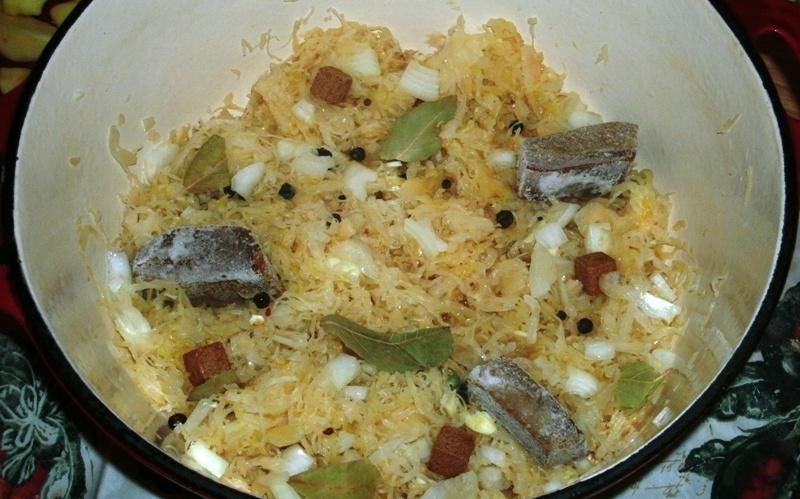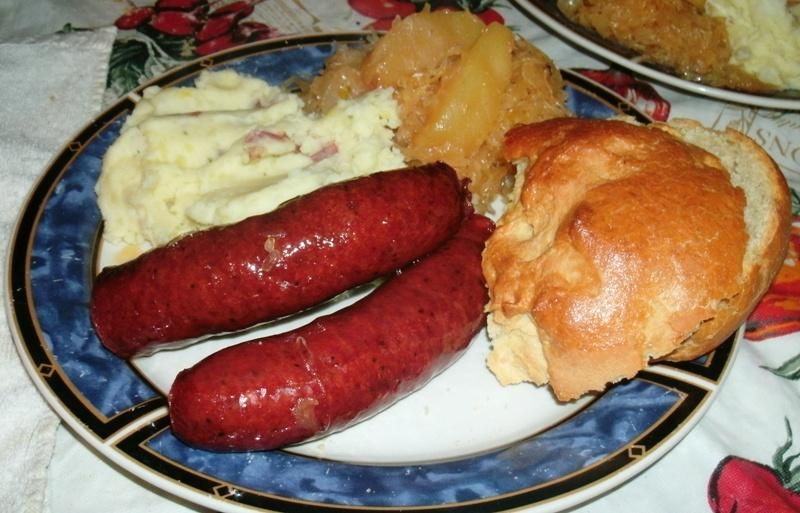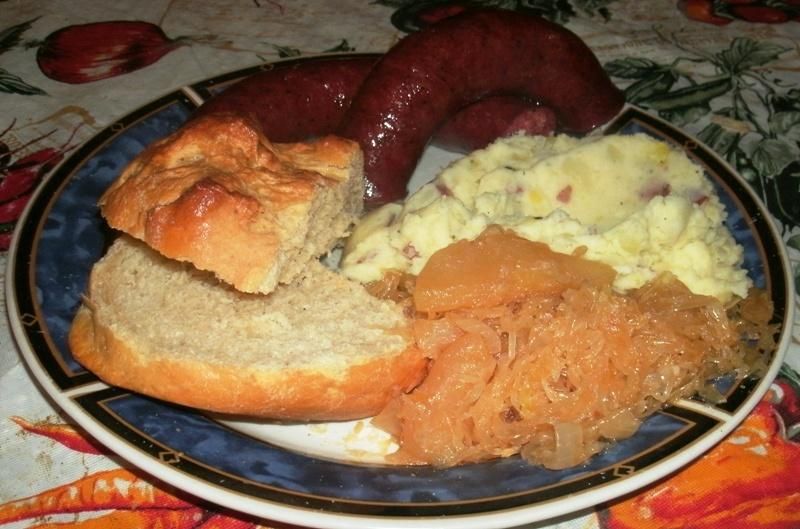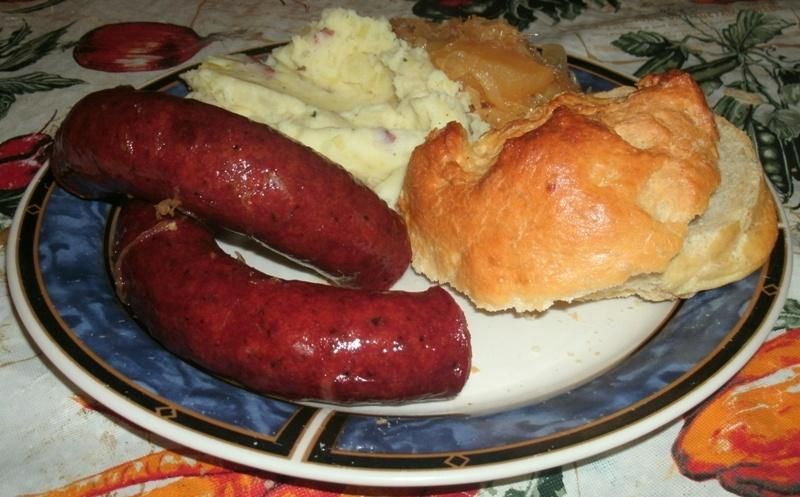

 The Accurate Reloading Forums
The Accurate Reloading Forums  THE ACCURATE RELOADING.COM FORUMS
THE ACCURATE RELOADING.COM FORUMS  Other Topics
Other Topics  Recipes for Hunters
Recipes for Hunters  My First Attempt at Sürkrüt Elsässer
My First Attempt at Sürkrüt ElsässerGo  | New  | Find  | Notify  | Tools  | Reply  |  |
| one of us |
My First Attempt at Sürkrüt Elsässer Choucroute Alsacienne The region of Alsace, which lies in north-eastern France on the border with Germany, has changed hands throughout the years, going back and forth between the two European powers; consequently, this robust province has absorbed many customs and ways of life associated with both, including architecture, language, hunting traditions and food.  One quintessential dish that is popular throughout the region, on both sides of the border, is Sürkrüt, which is the Alsatian word for the principle ingredient, sauerkraut, and commonly known by its French moniker, choucroute. Other prominent ingredients are sausages, bacon and smoked cuts of pork such as chops, loin, shoulder or rib tips, making this a truly interesting dish for those who are interested in charcuterie. Here are some photos from my first attempt at this dish. It can't really be called a "true" Alsatian choucroute, since there are a few things missing or substituted; however, it did turn out very well and made an excellent, hearty meal. I will certainly be preparing this "properly" in the future (sooner rather than later) and will put together a complete pictorial at that time, with background and other information. For now, suffice to say that this was an excellent choice that is easy, frugal and delicious. I prepared this dish in my trusty Tramontina enameled cast iron Dutch oven: http://www.walmart.com/ip/Tram...-Dutch-Oven/11989387 I am sure that any appropriately-sized casserole or baking dish would work, but I really enjoyed using this, as they were almost made for each other. The heat-retaining properites of the cast iron wrap around the food, heating it from all sides to wonderful perfection; additionally, the enameling on the cast iron protects it from the acid of the sauerkraut. First, I chopped an onion and tossed it with a quart of sauerkraut, laying the mixture down in the casserole as a bed. Easy! After doing some research, I learned that there are certain, traditional ingredients and spices that are common to nearly all preparations of this dish. Armed with this knowledge, I added a few peppercorns, bay leaves and juniper berries, along with some crushed garlic cloves. I did not add any salt, for reasons that shall become apparent in a moment:  Above, you can see the bed of sauerkraut and onion with the other spices. Since I had no stock, I added a couple-three beef bullion cubes (hence, no added salt) and also some small chunks of glace de poulet which we keep in the freezer (hence, the "frosty" look that they have in the picture). Over the years, I have found that the combination of chicken and beef (usually in the form of stock or glace) works very well to provide a delicious, mouth-watering quality to nearly any dish; in this case, my expectations were once again confirmed, with the savory meaty essence providing a nice counterbalance to the sweetness of the apples and the....well, the sourness of the sauerkraut. As mentioned above, I didn't have any bacon or smoked cuts of pork on hand to add to the dish, so I simply went with some kielbasa-type smoked sausages, cutting them into manageable lengths and adding them to the casserole. If anyone wants to make this "correctly," I'd suggest that the bacon used be rather thickly-cut and maybe 4 to 6 inches in length. I also added a couple of peeled and sliced apples, since they were mentioned prominently in my research:  I didn't have any Riesling in the house, either (having adult children at home can be a bad thing sometimes - my wine often disappears!); so instead, I used apple cider, using an amount that equaled the wine plus the stock. I believe this worked out very well, and would recommend it to anyone who does not have wine to use for this dish. I then covered the casserole and put it into the oven at 350 degrees for 90 minutes. Here's what we had when I was finished:  There was indeed more liquid than I expected, presumably from the apples and sausages etc.; no worries, I simply poured the cooking liquids into a container, defatted them (there was quite a bit of fat from the sausages) and added some back into the dish as a thin sauce, reserving the rest in order to add it to a batch of halušky that we made a couple of days later, using my wife's grandmother's method that she brought all the way from Slovakia to Montana: http://foodsoftheworld.activeb...-mamy_topic1253.html I served the finished sausages and sauerkraut with home-smashed, skin-on potatoes and individual "mini-loaves" of fresh-baked sourdough bread, using this recipe: http://foodsoftheworld.activeb...rolls_topic1178.html  Everyone was impressed with this, and as I said, it will certainly be made again. The combination of flavours was outstanding, bringing a little bit of everything to the party; sweet-tart apples and cider, hearty, spicy sausages and savory flavours from the onion and garlic. The other spices all played their parts in perfect harmony, providing accents and highlights that complimented the dish without being too prominent.  For some reason, I didn't get a picture of the potatoes with the sauce from the cooking liquids on them, but it was definitely there, and its piquant nature was just the right thing to go with the creamy, buttery potatoes. The entire dish was a hit as prepared, and I can't wait to try it again, made more properly.  Ironically, I've been making a similar dish for years, using wursts (würstchen?) or kielbasa along with beer, sauerkraut, mustard, onions and barley, but this had a whole different character to it that was very good. I'll post a pictorial of that dish the next time we make it. Thanks to all for looking ~ now that you've seen it, why not give it a try? Any questions, just ask! Ron | ||
|
| Powered by Social Strata |
| Please Wait. Your request is being processed... |
|
 The Accurate Reloading Forums
The Accurate Reloading Forums  THE ACCURATE RELOADING.COM FORUMS
THE ACCURATE RELOADING.COM FORUMS  Other Topics
Other Topics  Recipes for Hunters
Recipes for Hunters  My First Attempt at Sürkrüt Elsässer
My First Attempt at Sürkrüt Elsässer

Visit our on-line store for AR Memorabilia

